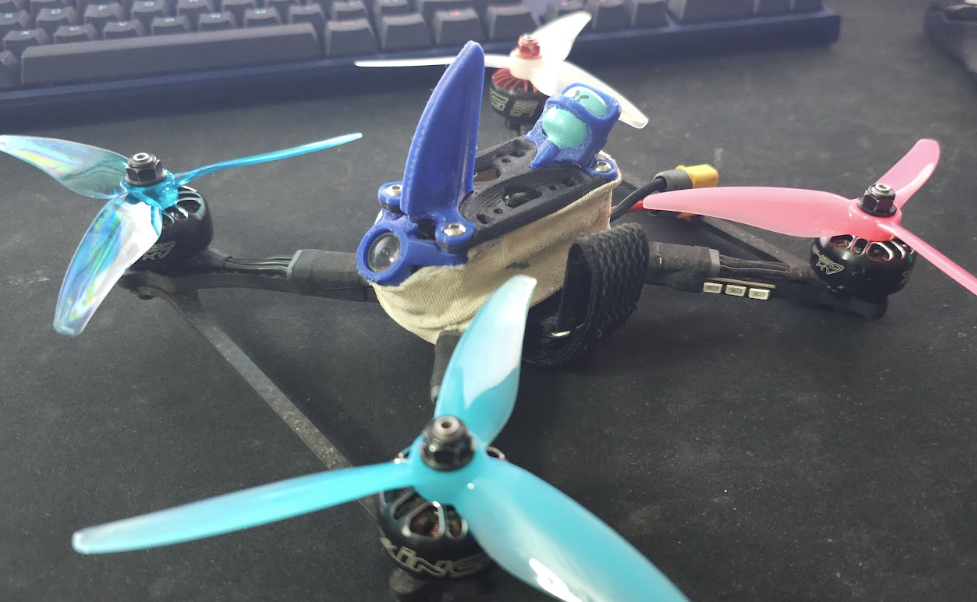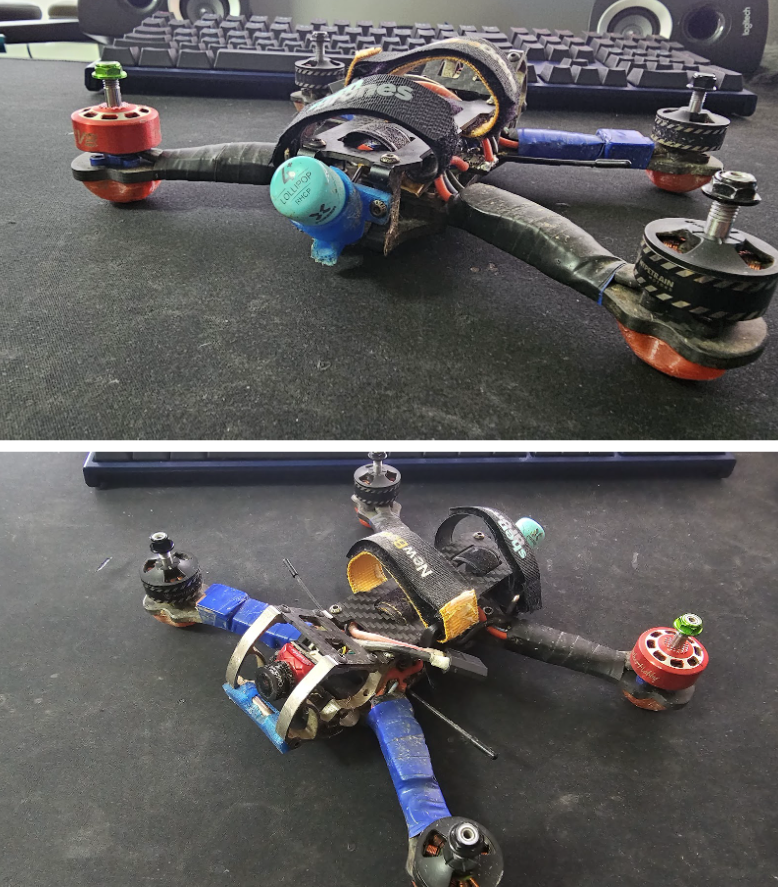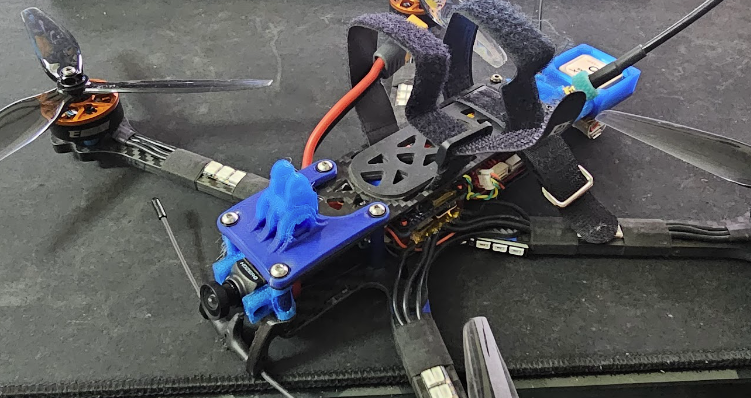When it comes to building FPV drones, pilots inevitably will find themselves facing a decision whether to build their aircraft with the goal of being ultra lightweight or with the goal of being ultra durable. Neither approach is perfect for every situation. In this article I will give a rundown about three classes of FPV drones and reasons why prioritizing weight or durability may be the best option for you.
5” Racing
In most racing situations, FPV Drone weight is more important than FPV drone durability. Heavier drones waste energy by carrying more weight. That wasted battery can be the difference between finishing last and being the next champion!
Many pilots feel that less weight translates to better responsiveness on a track. Manufacturers keep this in mind, which means racing-focused parts are designed to be lighter. The top-performing racing frames (without 3D printed parts) weigh in at about 50 grams. A set of four motors is typically 120 grams (~30 grams each), and a set of four props is about 16.8 grams (~4.2 grams each). Add the battery, which is typically under 230 grams. It’s a quick 416 grams without accounting for the flight stack, receiver, and video system.
If a pilot prioritizes FPV drone durability, the weight can quickly stack up. Accessories like flip sticks, battery shields, arm braces, and arm protectors increase survivability in crashes. Drones built for durability can crash harder without the risk of damaging the frame. A heavy racing drone can also be involved in a mid-air collision and be more likely to continue flying because of the preservation of mass – it’s simple physics!
There is a balance that average racers strike that allows for their drones to crash and not get destroyed and still be light enough to accommodate greater maneuverability. Some racers like to train with a heavy drone, and compete with a light drone. This approach lets them practice without having to spend as much time making repairs and gives them a competitive edge in big races.
A brief note on spec-racing, some leagues intentionally make drones heavier. The racing is closer because more weight forces pilots to fly more precisely and conserve momentum around turns. These races are more about individual pilot skills than they are about who has the fastest drone. Crashes are slower, which is less likely to damage equipment, and therefore, you should prioritize FPV drone durability for spec racing.
My racing drones weigh in at 309 grams with two arm braces and a “stack saver,” which protects the flight stack from getting coated in dirt when I crash. I have found a balance of weight and durability that lets me crash hard and get up and keep going. This is exactly how I was able to perform as well as I did in the 2023 MultiGP Sportsman Championship!

Freestyle – Build for the fall
Freestyle FPV drone durability is much more important than having a lightweight aircraft. Most freestyle pilots are carrying a GoPro, and have all sorts of 3D printed accessories that increase durability at the cost of extra weight. Freestyle frames usually use thicker carbon fiber plates, which increases durability because it is much less likely to break when you crash. 3D printed accessories also help improve durability, at the cost of weight.
Parts like arm bumpers, landing skids, or “chin” guards are practical because they can get chewed up in crashes instead of letting the carbon get damaged. Other parts, like a GoPro mount, are designed to protect the camera from heavy impacts and, therefore, will add weight to your drone. If you do not have your own 3D printer, I recommend looking at Brain3d.com for parts to add to your drone as needed. I really like their arm bumpers and wide range of GoPro mounts.
Something worth noting, too, is that freestyle crashes are slower, albeit less forgiving, especially if you fly in concrete office parks or abandoned buildings, which also increases durability – just like how accidentally bumping your hip against a table hurts much less than running into it at full speed. Pilots can afford a little extra durability to protect their frame. A heavier freestyle FPV drone also has the benefit of being able to “throw” itself into different tricks. This helps pull off some of those more gravity-defying tricks. If you want to learn how to do some of those tricks, I recommend YouTuber Headmazta who makes great videos about performing some pretty complex maneuvers.
My most reliable freestyle FPV drone is built with durability as the priority. It weighs 399 grams and has a 3D-printed antenna mount, chin guard, and landing skids. On the arms, there are old broken props that cover the ESCs, and the whole thing is conformal coated to protect against shorting when I crash during the winter.

Long Range – Birds are light and they fly far… right?
For medium to long range applications, FPV drone weight is prioritized because these drones almost never will be put into a position where they will be thrashed around like a freestyle drone. Long-range drones are built with efficiency in mind, which means highly optimized motor-prop combinations and frames with less carbon in them (or carbon-foam sandwiches). The whole point is getting from point A to point B and back without losing your drone. Websites like e-calc can help you find the right balance of parts to make the most efficient, lightweight FPV drone.
YouTubers like Falcon Rad offer great tutorials on selecting parts for long-range missions. He focuses on bringing the dry weight of his drones down (weight without the battery and GoPro) so he can put larger batteries on the drone. Larger batteries translate to longer flight times.
On my personal long range FPV drone I have reduced it down to 626 grams without a battery. It is exactly 1103 grams with a battery and has seventeen-minute flight times. The only 3D-printed parts are a GPS mount and a GoPro mount. Both are printed with low infill to reduce mass. I do everything I can to avoid crashing it, and I always try to land it gently to protect the arms from delaminating against the ground.

Final thoughts
In some parts of the world, building an FPV drone to be lightweight helps get around some federal regulations. The magic number in America is 250 grams, before it needs to be registered with the FAA with a remote ID module. If you want to avoid this regulation, a lightweight build will be your friend. Sub 250-gram FPV Drones lack the durability of their larger counterparts but are less likely to get you in trouble.





